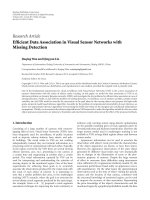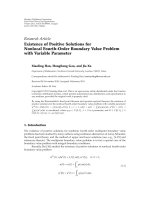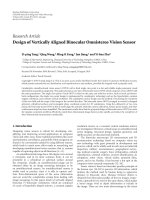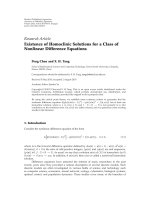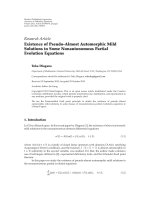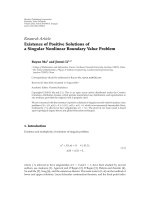báo cáo hóa học:" Research Article Existence of Periodic Solutions of Linear Hamiltonian Systems with Sublinear Perturbation" ppt
Bạn đang xem bản rút gọn của tài liệu. Xem và tải ngay bản đầy đủ của tài liệu tại đây (502.64 KB, 12 trang )
Hindawi Publishing Corporation
Boundary Value Problems
Volume 2010, Article ID 945421, 12 pages
doi:10.1155/2010/945421
Research Article
Existence of Periodic Solutions of Linear
Hamiltonian Systems with Sublinear Perturbation
Zhiqing Han
School of Mathematical Sciences, Dalian University of Technology, Dalian 116023, Liaoning, China
Correspondence should be addressed to Zhiqing Han,
Received 2 June 2009; Revised 4 February 2010; Accepted 19 March 2010
Academic Editor: Ivan T. Kiguradze
Copyright q 2010 Zhiqing Han. This is an open access article distributed under the Creative
Commons Attribution License, which permits unrestricted use, distribution, and reproduction in
any medium, provided the original work is properly cited.
We investigate the existence of periodic solutions of linear Hamiltonian systems with a nonlinear
perturbation. Under generalized Ahmad-Lazer-Paul type coercive conditions for the nonlinearity
on the kernel of the linear part, existence of periodic solutions is obtained by saddle point theorems.
A note on a result of Rabinowitz is also given.
1. Introduction
For the second-order Hamiltonian system
¨u
t
∇F
t, u
t
0,u
0
− u
T
˙u
0
− ˙u
T
0, 1.1
the existence of periodic solutions is related to the coercive conditions of Ft, u on u.This
fact is first noticed by Berger and Schechter 1 who use the coercive condition Ft, u →−∞
as |u|→∞, uniformly for a.e. t ∈ 0,T. Subsequently, Mawhin and Willem 2 consider it by
using more general coercive conditions of an integral form. More precisely, they assume that
Ft, u : 0,T × R
N
→ R
N
is bounded |∇Ft, u|≤gt for some gt ∈ L
1
0,T with some
additional technical conditions and satisfies one of the following Ahmad-Lazer-Paul type 3
coercive conditions:
lim
u
→∞ u∈R
N
T
0
F
t, u
dt ±∞,
1.2
2 Boundary Value Problems
then they obtain the existence of at least one solution. How to relax the boundedness of F is a
problem which attracted several authors’ attention, for example, see 4, 5 and the references
therein.
In 6, 7, the nonlinearity is allowed to be unbounded and satisfy
|
∇F
t, u
|
≤ g
t
|
u
|
α
h
t
, 1.3
where 0 ≤ α<1andgt,ht ∈ L
2
0, 2π and satisfy one of the generalized Ahmad-Lazer-
Paul type coercive conditions
lim
u
→∞ u∈ R
N
u
−2α
2π
0
F
t, u
dt ±∞,
1.4
the same results are obtained. In fact, a more general system is considered and the above
results are just a special case as A 0 of the results there. The conditions which are useful
to deal with problems 1.1 are used in recent years by several authors; see 4, 8 and the
references therein for some further information. For some recent developments of the second-
order systems 1.1,see9.
In this paper, we use this kind of condition to consider the existence of periodic
solutions of first-order linear Hamiltonian system with a nonlinear perturbation
˙u JA
t
u J∇G
u, t
, 1.5
where At is a symmetric 2π-periodic 2N × 2N continuous matrix function, Gu, t ∈
C
1
R
2N
× R, R is 2π-periodic for t, and J is the standard symplectic matrix
J
0 −I
N
I
N
0
. 1.6
The 2π-periodic solutions of the problem correspond to the critical points of the
functional
Φ
u
1
2
2π
0
−J ˙u − A
t
u
· udt−
2π
0
G
u, t
dt
1.7
on the Hilbert space E : W
1/2
S
1
, R
2N
. We recall that E is a Sobolev space of 2π-periodic
R
2N
-valued functions
u
t
a
0
∞
k1
a
k
cos kt b
k
sin kt, a
0
,a
k
,b
k
∈ R
2N
1.8
with inner product
u, u
: 2πa
0
· a
0
π
∞
k1
k
a
k
a
k
b
k
b
k
, 1.9
Boundary Value Problems 3
and E is compactly hence continuously imbedded into L
s
S
1
, R
2N
for every s ≥ 1 10.That
is for every s ≥ 1
E ⊂⊂ L
s
S
1
, R
2N
. 1.10
A compact self-adjoint operator on E can be defined by
Vu,w
:
2π
0
A
t
u · wdt.
1.11
Define another self-adjoint operator on E
Uu, w
:
2π
0
−J ˙u · wdt,
1.12
and denote U − V by L. Hence Φu has the form
Φ
u
1
2
Lu, u
− ϕ
u
, 1.13
where ϕu
2π
0
Gu, tdt.
We make the following assumptions.
G
1
There exists 0 ≤ α<1 such that ∇Gu, tO|u|
α
O1 uniformly for t ∈
0, 2π,u∈ R.
G
2
∇Gu, to|u| uniformly for t ∈ 0, 2π as |u|→∞.
G
±
G
G
−
lim
u
→∞,u∈NL
2π
0
G
u
t
,t
dt
u
2α
∞, G
lim
u
→∞,u∈NL
2π
0
G
u
t
,t
dt
u
2α
−∞, G
−
where NL{u ∈ E | Lu 0}. It is easily seen that u ∈ NL if and only if u ∈ E
is a 2π-periodic solution of the f ollowing linear problem:
˙u JA
t
u. 1.14
It is a standard result that the self-adjoint operator L on E has discrete eigenvalues:
··· ≤ λ
−2
≤ λ
−1
< 0λ
0
<λ
1
≤ λ
2
≤ ··· . Let e
±j
denote the eigenvectors of L corresponding to
4 Boundary Value Problems
λ
±j
, respectively. Define
E span
j≥1
{e
j
}, E span
j≥1
{e
−j
},andE
0
ker L. Hence there exists
a decomposition E
E ⊕ E
0
⊕
E, where dim E
0
< ∞ and
E, E are all infinite dimensional.
Denote correspondingly for every u ∈ E, u
u u
0
u. It is more convenient to introduce the
following equivalent inner product on E. For u, v ∈ E, u
u u
0
u, v v v
0
v, we define
u, v
Lu, u
−
L
u, u
u
0
,v
0
. 1.15
The induced norm is still denoted by ·. Then Φu has the form
Φ
u
1
2
u
2
−
1
2
u
2
− ϕ
u
.
1.16
Now we can state the main results of the paper.
Theorem 1.1. Suppose that the condition G
1
holds. Furthermore, we assume that one of the
conditions G
±
holds. Then the Hamiltonian system 1.5 has at least one 2π-periodic solution.
Theorem 1.2. Assume that the linear problem 1.14 has only the trivial 2π-periodic solution u 0
and the condition G
2
holds. Then the Hamiltonian system 1.5 has at least one 2π-periodic solution.
Remark 1.3. Theorem 1.2 is essentially known in the literature by various methods, for
example, see 11–15. Here we prove it and Theorem 1.1 by using variational methods in
a united framework.
Remark 1.4. When one of the conditions G
±
holds, the critical groups at infinity for the
functional 1.16 can be clearly computed, for example, see 8, 16 or 17 for the bounded
nonlinearity. Hence at least one critical point of Φu can be obtained. But for the use of Morse
theory, more regularity restrictions than those in the above theorems about Gt, u have to be
used.
2. Proofs the Theorems
As to the investigation of 1.1, we need to use the saddle point theorem in the variational
methods. But contrary to the functional corresponding to 1.1, which is semidefinite, the
functional Φu is strongly indefinite which means that the positive and negative indees for
the linear part are all infinite. Hence we need another version of the saddle point theorem
see Theorem 5.29 and Example 5.22 in 10 which we state here.
Theorem 2.1. Let E be a real Hilbert space with E E
1
⊕ E
2
and E
2
E
⊥
1
. Suppose Φ ∈ C
1
E, R
satisfies (PS) condition and
1Φu1/2Lu, ubu, where Lu L
1
P
1
u L
2
P
2
u and L
i
: E
i
→ E
i
are b ounded and
self-adjoint, i 1, 2,
2 b
is compact,
3 there are constants α>ωsuch that
I
|
E
2
≥ α, I
|
∂Q
≤ ω, Q B ∩ E
1
,Bis a ball in E
1
. 2.1
Then Φ possesses a critical value c ≥ α.
Boundary Value Problems 5
Proof of Theorem 1.1. We use Theorem 2.1. and only consider the case where G
holds. The
other case can be similarly treated. Set E E
1
⊕ E
2
: E ⊕ E
0
⊕
E. It is clear that conditions
1 and 2 in Theorem 2.1 hold. Now we prove that the functional Φ satisfies PS condition
on E. In the following, C denotes a universal positive constant, and ·, · denotes the paring
between E
and E.
Suppose that Φ
u
n
→ 0asn →∞and |Φu
n
|≤C, for all n ≥ 1.
C
u
n
≥
Φ
u
n
, −
u
n
u
n
, u
n
2π
0
∇G
t, u
n
u
n
≥
u
n
2
−
2π
0
C C
u
n
u
0
n
u
n
α
|
u
n
|
dt
≥
u
n
2
− C
u
n
− C
2π
0
|
u
n
|
1α
u
0
n
α
|
u
n
|
|
u
n
|
α
|
u
n
|
dt
≥
u
n
2
− C
u
n
− C
u
n
1α
− C
u
0
n
α
u
n
−
u
n
2
− C
u
n
2α
2.2
≥
1
2
u
n
2
− C
u
0
n
α
u
n
− C
u
n
2α
, 2.3
for every >0.
In the proof of 2.2, we use the imbedding result 1.10, the finite dimensionality of
E
0
, and Young inequality. In the proof of
2π
0
|
u
n
|
α
|
u
n
|
dt ≤
u
n
2
C
u
n
2α
,
2.4
we need a little bit of caution. First, as α 0, it is clear. Hence we suppose that 0 <α<1.
Choosing p>1sufficiently large such that pα > 1, then using H
¨
older inequality and the
imbedding result 1.10, we have
2π
0
|
u
n
|
α
|
u
n
|
dt ≤
2π
0
|
u
n
|
pα
1/p
2π
0
|
u
n
|
q
1/q
≤
u
n
α
u
n
,
2.5
where 1/p 1/q 1.
Hence from 2.3,we get
u
n
2
≤ C
u
0
n
2α
C
u
n
2α
.
2.6
By estimating Φ
u
n
, u
n
and a similar argument as above, we can get
u
n
2
≤ C
u
0
n
2α
C
u
n
2α
.
2.7
6 Boundary Value Problems
Combining 2.6 and 2.7 and noticing the fact that 0 ≤ α<1, we have
u
n
2
≤ C
u
0
n
2α
,
u
n
2
≤ C
u
0
n
2α
.
2.8
In order to prove that {u
0
n
} and hence {u
n
} are bounded, we need much work.
By 2.8, we have
−C ≤ Φ
u
n
1
2
u
n
2
−
1
2
u
n
2
−
2π
0
G
t, u
n
dt
≤ C
u
0
n
2α
−
2π
0
G
t, u
n
− G
t, u
0
n
dt
2π
0
G
t, u
0
n
dt.
2.9
We want to prove that
2π
0
G
t, u
n
− G
t, u
0
n
dt
≤ C
u
0
n
2α
C. 2.10
In fact
2π
0
G
t, u
n
− G
t, u
0
n
dt
2π
0
1
0
∇G
t, u
0
n
s
u
n
u
n
u
n
u
n
ds
dt
≤
2π
0
C C
u
0
n
α
|
u
n
|
α
|
u
n
|
α
|
u
n
u
n
|
dt.
2.11
Now, to get 2.10, we use a similar argument as that in the proof of 2.2 and the
inequalities 2.8.
Hence we get the inequality
−C ≤ C
u
0
n
2α
−
2π
0
G
t, u
0
n
dt. 2.12
Hence by condition G
and Lemma 3.1in6 or by a direct reasoning, we have that
{u
0
n
} must be bounded. So {u
n
} is bounded in E by 2.8. Using a same argument in 10,
we prove that Φ satisfies the PS condition on E.
Finally we verify the conditions 3 in Theorem 2.1.
Recall that we set E E
1
⊕ E
2
: E ⊕ E
0
⊕
E.
Boundary Value Problems 7
As u ∈
E, u u, we have
Φ
u
1
2
u
2
−
2π
0
G
t, u
dt
1
2
u
2
−
2π
0
G
t, 0
dt −
2π
0
G
t, u
− G
t, 0
dt
1
2
u
2
−
2π
0
G
t, 0
dt −
2π
0
1
0
∇G
t, su
uds
dt
≥
1
2
u
2
− C − C
u
1α
,
2.13
where we used condition G
1
. Noticing that α<1, we have that Φu is bounded below on
E.
As u ∈
E ⊕ E
0
, u u u
0
, we have
Φ
u
−
1
2
u
2
−
2π
0
G
t, u
dt
−
1
2
u
2
−
2π
0
G
t, u
0
dt −
2π
0
G
t, u
− G
t, u
0
dt
−
1
2
u
2
−
2π
0
G
t, u
0
dt −
2π
0
1
0
∇G
t, u
0
su
uds
dt
≤−
1
4
u
2
−
2π
0
G
t, u
0
dt C
u
0
2α
C,
2.14
where we used Young i nequality and condition G
1
and omitted some simple details. Hence
Φu →−∞as u ∈
E ⊕ E
0
and u→∞, by condition G
.
This completes the proof.
Proof of Theorem 1.2. We still use Theorem 2.1. and only consider the case where G
holds.
Under the assumption of the theorem, E
0
0. We set E E
1
⊕ E
2
: E ⊕
E. It is clear that
conditions 1 and 2 in Theorem 2.1 hold. N ow we prove that the functional Φ satisfies PS
condition on E.
By G
2
, for every >0, there exists C > 0 such that
|
∇G
t, u
|
≤
|
u
|
C
2.15
for all t ∈ R, u ∈ R
2N
.
8 Boundary Value Problems
Suppose that Φ
u
n
→ 0asn →∞and |Φu
n
|≤C.
C
u
n
≥
Φ
u
n
, −
u
n
u
n
, u
n
2π
0
∇G
t, u
n
u
n
dt
≥
u
n
2
−
2π
0
|
u
n
|
C
|
u
n
|
dt
≥
u
n
2
− C
u
n
2
− C
u
n
2
− C
u
n
2
− C
u
n
.
2.16
Hence we get
u
n
2
≤ C
u
n
2
C
.
2.17
Similarly, by estimating Φ
u
n
, −u
n
, we can get
u
n
2
≤ C
u
n
2
C
.
2.18
By combining the above two inequalities and fixing >0 small, we get that {u
n
} is
bounded in E. Hence an argument in 10 shows that the PS condition hold.
As u ∈
E, u u, we have
Φ
u
1
2
u
2
−
2π
0
G
t, u
dt
1
2
u
2
−
2π
0
G
t, 0
dt −
2π
0
1
0
∇G
t, su
uds
dt
≥
1
2
u
2
− C
− C
u
2
.
2.19
As u ∈
E, we have
Φ
u
−
1
2
u
2
−
2π
0
G
t, u
dt
−
1
2
u
2
−
2π
0
G
t, 0
dt −
2π
0
1
0
∇G
t, su
uds
dt
≤−
1
2
u
2
C
u
2
C
.
2.20
By fixing >0 such that C < 1/2, we get that the conditions 3 in Theorem 2.1 hold.
Hence we complete the proof.
Boundary Value Problems 9
Remark 2.2. In order to check the conditions G
±
involving the unknown functions in the
kernel NL, we present the following proposition.
Proposition 2.3. Suppose that ∇Gt, u satisfies G
1
and there exist βt,γt ∈ L
1
0, 2π such
that the following limits are uniform for a.e. t ∈ 0, 2π:
β
t
≤ lim inf
|
u
|
→∞
∇G
t, u
,u
|
u
|
1α
≤ lim sup
|
u
|
→∞
∇G
t, u
,u
|
u
|
1α
≤ γ
t
.
2.21
Then (i) if βt ≥ 0,a.e.t ∈ 0, 2π and
2π
0
βtdt > 0, G
holds; (ii) if γt ≤ 0,a.e.t ∈ 0, 2π
and
2π
0
γtdt < 0, G
−
holds.
Proof. The case i is proved in 4 and the case ii can be similarly proved.
3. A Note on a Result of Rabinowitz
In this Section, we give a note about a result in 18. Following the same method, we will
prove the following result.
Theorem 3.1. Let Gt, u satisfy the following conditions: 1 Gt, u ≥ 0 for all t ∈ 0, 2π and
u ∈ R
2N
, 2 Gt, uo|u|
2
as u → 0, uniformly for t ∈ 0, 2π, 3 there exists μ>2, r and
1 <μ
∗
<μsuch that
0 <μG
t, u
≤ u∇G
t, u
, 3.1
|
∇G
t, u
|
≤ C
|
u
|
μ
∗
,
3.2
for all |u|≥
r and t ∈ 0, 2π.Then1.5 has at least one nonzero 2π-periodic solution.
Remark 3.2. When the condition 3.2 is replaced by the following one there are constants
α, R
1
> 0 such that |∇Gt, u|≤αu, ∇Gt, u for all t ∈ R, u ∈ R
2N
, |u| >R
1
. The above
result is proved by Rabinowitz 18. When the condition 3.2 is replaced by a condition
which measures the difference of the system from an autonomous one, the problem is also
considered by 19.
Proof of Theorem 3.1. We basically follow the same method as that in 10, 18. But under
the condition 3.2, we do not need the truncation method there and just use a variant of
Theorem 2.1 generalized mountain pass lemma.
As in Section 1,thesolutionsof1.5 correspond to the critical points of
Φ
u
1
2
u
2
−
1
2
u
2
−
2π
0
G
t, u
dt
3.3
on E. We divide the proof to several steps.
10 Boundary Value Problems
Step 1. Conditions 1 and 2 in Theorem 2.1 hold. It is clear.
Step 2. Set E E
1
⊕ E
2
: E ⊕ E
0
⊕
E. By conditions 2 and 3, for every >0, there exists
C > 0 such that
|
∇G
t, u
|
≤
|
u
|
2
C
|
u
|
μ
∗
1
,
3.4
for all t ∈ R, u ∈ R
2N
. Hence, as u ∈
E, we have
Φ
u
≥
1
2
u
2
− C
u
2
− C
u
μ
∗
1
.
3.5
Hence by fixing >0 small, we can obtain ρ>0,τ > 0 such that Φu ≥ τ>0 for all
u ∈ ∂B
ρ
∩ E
1
.
Step 3. Choose e ∈ ∂B
ρ
∩ E
1
and set Q {re | 0 ≤ r ≤ r
1
}⊕B
r
2
∩ E
2
. Define E
∗
span{e}⊕E
2
so Q ⊂ E
∗
. Using a same method as 10, Lemma 6.20, we have Φu ≤ 0on∂Q after suitable
choices of r
1
and r
2
, where the boundary is taken in E
∗
.
Step 4. By condition 3.1, we have
G
t, u
≥ C
|
u
|
μ
− C, 3.6
for some C>0andallt ∈ R, u ∈ R
2N
.
Now we verify the PS condition.
Suppose that Φ
u
n
→ 0asn →∞and |Φu
n
|≤C, for all n ≥ 1.Then
C
u
n
≥ Φ
u
n
−
1
2
Φ
u
n
u
n
2π
0
1
2
u
n
·∇G
t, u
n
− G
t, u
n
dt
≥
1
2
−
1
μ
2π
0
u
n
·∇G
t, u
n
dt − C
≥ C
u
n
μ
L
μ
− C,
3.7
for some C>0. Furthermore, by 3.7, we have
C
u
n
≥ C
u
n
2
L
2
μ/2
≥ C
u
0
n
μ
L
2
≥ C
u
0
n
μ
.
3.8
Boundary Value Problems 11
Now we turn to estimate other terms.
u
n
2
Φ
u
n
, u
n
2π
0
∇G
t, u
n
u
n
dt
≤
2π
0
|
u
n
|
μ
∗
|
u
n
|
dt C
u
n
≤ C
u
n
μ
∗
L
μ
u
n
C
u
n
.
3.9
Hence
u
n
≤ C
u
n
μ
∗
L
μ
C.
3.10
Therefore, using 3.7,weget
u
n
≤ C
u
n
μ
∗
/μ
C.
3.11
Similarly, we also have
u
n
≤ C
u
n
μ
∗
/μ
C.
3.12
Combining 3.8, 3.11,and3.12, we have
u
n
≤ C
u
n
1/μ
C
u
n
μ
∗
/μ
C.
3.13
Hence {u
n
} must be bounded. By a standard argument, the PS condition holds.
Now the theorem is proved by Theorem 5.29 in 10.
Acknowledgments
The author thanks the referees for the comments and further references, which are important
for the revision of the paper. Part of the work is supported by CSC and a science fund from
Dalian University of Technology. The author thanks Professor. Rabinowitz and the members
at Mathematics Department of Wisconsin University at Madison for their hospitality during
his visit there. The author also thanks Professor Liu Zhaoli for discussions about an argument
in this paper.
References
1 M. S. Berger and M. Schechter, “On the solvability of semilinear gradient operator equations,”
Advances in Mathematics, vol. 25, no. 2, pp. 97–132, 1977.
2 J. Mawhin and M. Willem, Critical Point Theory and Hamiltonian Systems, vol. 74 of Applied Mathematical
Sciences, Springer, New York, NY, USA, 1989.
12 Boundary Value Problems
3 S. Ahmad, A. C. Lazer, and J. L. Paul, “Elementary critical point theory and perturbations of elliptic
boundary value problems at resonance,” Indiana University Mathematics Journal, vol. 25, no. 10, pp.
933–944, 1976.
4 Z. Q. Han, “2π-periodic solutions to ordinary differential systems at resonance,” Acta Mathematica
Sinica. Chinese Series, vol. 43, no. 4, pp. 639–644, 2000.
5 S. B. Robinson and E. M. Landesman, “A general approach to solvability conditions for semilinear
elliptic boundary value problems at resonance,” Differential and Integral Equations, vol. 8, no. 6, pp.
1555–1569, 1995.
6 Z. Q. Han, “2π-periodic solutions to N-dimmensional systems of Duffing’s type I,” D. Guo, Ed.,
Nonlinear Analysis and Its Applications, pp. 182–191, Beijing Scientific & Technical Publishers,
Beijing, China, 1994.
7 Z. Q. Han, “2π-periodic solutions to N-dimmensional systems of Duffing’s type II,” Journal of
Qingdao University, vol. 7, pp. 19–26, 1994.
8 Z Q. Han, “Computations of cohomology groups and nontrivial periodic solutions of Hamiltonian
systems,” Journal of Mathematical Analysis and Applications, vol. 330, no. 1, pp. 259–275, 2007.
9 M. Schechter, “Periodic non-autonomous second-order dynamical systems,” Journal of Differential
Equations, vol. 223, no. 2, pp. 290–302, 2006.
10 P. H. Rabinowitz, Minimax Methods in Critical Point Theory with Applications to Differential Equations,
vol. 65 of CBMS Regional Conference Series in Mathematics, A.M.S, Providence, RI, USA, 1986.
11 R. Conti, “Equazioni differenziali ordinarie quasilineari con condizioni lineari,” Annali di Matematica
Pura ed Applicata. Serie Quarta, vol. 57, pp. 49–61, 1962.
12 I. T. Kiguradze, “Boundary value problems for systems of ordinary differential equations,” in
Sovremennye Problemy Matematiki
, vol. 30 of Itogi Nauki i Tekhniki, pp. 3–103, Akad. Nauk SSSR
Vsesoyuz. Inst. Nauchn. i Tekhn. Inform., Moscow, Russia, 1987, Translated in Journal of Soviet
Mathematics, vol. 43, no. 2, pp. 2259–2339, 1988.
13 M. A. Krasnosel’skii, The Operator of Translation Along the Trajectories of Differential Equations, vol. 19 of
Tr anslations of Mathematical Monographs , American Mathematical Society, Providence, RI, USA, 1968.
14 R. Reissig, G. Sansone, and R. Conti, Nichtlineare Differentialgleichungen h
¨
oherer Ordnung, Consiglio
Nazionale delle Ricerche Monografie Matematiche, No. 16, Edizioni Cremonese, Rome, Italy, 1969.
15 M. Roseau, Solutions Periodiques ou Presque Periodiques des Systemes Differentiels de la Mecanique non
Lineaire, Courses and Lectures, International Centre for Mechanical Sciences, Udine, Italy, 1970.
16 S. Li and J. Q. Liu, “Computations of critical groups at degenerate critical point and applications to
nonlinear differential equations with resonance,” Houston Journal of Mathematics,vol.25,no.3,pp.
563–582, 1999.
17 K. C. Chang, Infinite Dimensional Morse Theory and Multiple Solution Problem,Birkha
¨
user, Berlin,
Germany, 1991.
18 P. H. Rabinowitz, “On subharmonic solutions of Hamiltonian systems,” Communications on Pure and
Applied Mathematics, vol. 33, no. 5, pp. 609–633, 1980.
19 Y. Long and X. J. Xu, “Periodic solutions for a class of nonautonomous Hamiltonian systems,”
Nonlinear Analysis: Theory, Methods & Applications, vol. 41, no. 3-4, pp. 455–463, 2000.



